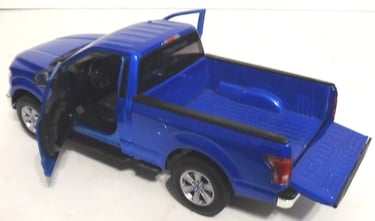Diecast Cars as an Investment
Some diecast cars can be good investments, but it's important to understand the factors that drive their value. The market for diecast cars is projected to grow, with the global market size estimated at $4.9 billion in 2023 and forecasted to reach $7 billion by 2030. The 1:18 scale segment is also seeing strong growth, valued at $1.2 billion in 2024 and projected to reach $2.5 billion by 2033.
Factors increasing diecast car value
Rarity and Limited Editions: Models produced in limited quantities, special releases, or those no longer manufactured tend to increase in value due to scarcity. Old Hot Wheels, for instance, have seen significant appreciation.
Condition and Packaging: Models in pristine, "mint" condition, especially those in their original packaging ("Mint in Box" or "Mint on Mint Card"), are highly desirable and fetch higher prices.
Historical and Cultural Significance: Replicas of vehicles with important historical or cultural ties, such as classic cars (like the Porsche 911 or Jaguar E-Type), famous movie cars (like the James Bond Aston Martin DB5), or racing heritage, tend to hold and appreciate in value. The 1969 Pink Rear-Loading Volkswagen Beach Bomb, for example, sold for $125,000 due to its rarity and unique history.
Brand and Manufacturer Reputation: Well-established brands known for quality and detail, such as Hot Wheels, Matchbox, Autoart, Minichamps, Tomica, Corgi, Dinky, and CMC, are more likely to retain or increase in value. Models from older manufacturers, especially if their early products are rare classics, can be particularly valuable.
Age and Nostalgia: Older models, particularly those from the 1950s and 1960s, are generally harder to find and more valuable, especially if in good condition. Newer generations are also driving interest in cars from the 1980s and 1990s, such as the Nissan Skyline GT-R and BMW M3.
Scale and Detail: Larger scales, such as 1:18, allow for greater detail and tend to be more expensive and desirable, especially for collectors focused on high precision.
Market Demand and Trends: Popularity shifts over time, but racing series (Formula 1, NASCAR), movie cars, and classic cars remain in high demand. Events like a racer's retirement or championship win can also temporarily increase value for related models.
Brands with investment potential
Hot Wheels: Despite being widely available, some rare or vintage Hot Wheels models can be highly valuable. Examples include:
1969 Pink Rear-Loading Volkswagen Beach Bomb ($125,000 in 2011)
1971 Purple Olds 442 (up to $12,000 in mint condition)
1968 Over Chrome Mustang ($40,000)
Matchbox: Known for realism and durability; certain older or limited-edition models can be valuable.
Dinky Toys: Pre-war models are particularly valuable due to age and rarity, such as the
No. 22D Delivery Van 'W.E. Boyce' (valued at over £20,000 in 2009).
CMC: Considered the pinnacle of diecast collecting, known for intricate details and high prices, often appreciating in value, especially after discontinuation.
Autoart: Renowned for exceptional detail and quality, making them favorites for serious collectors.
Other brands: Greenlight Collectibles, M2 Machines, Kyosho, Almost Real, and BBR also produce highly detailed and sought-after models.
What other factors impact a diecast car's investment potential?
Other factors beyond rarity and brand reputation significantly influence a diecast car's investment potential:
Condition and Packaging:
Diecast models in pristine, mint condition, especially those in their original packaging ("Mint in Box" or "Mint on Mint Card"), are highly valued by collectors. The packaging itself adds significant value (potentially 20% or more), protecting the car, confirming authenticity, and potentially detailing production numbers. Even minor flaws, like small scratches or dust, can noticeably reduce value, highlighting the importance of proper storage and handling.
Scale and Detail:
Larger scales like 1:18 or 1:12 offer greater detail and are often considered more valuable collector's items than smaller scales like 1:64. Models with intricate features, authentic paint finishes, opening parts, or even electronic components are more appealing to serious collectors.
Historical and Cultural Significance:
Replicas of vehicles tied to significant cultural moments, racing history, or famous figures (e.g., championship-winning cars, movie vehicles, or icons like the Ford GT40 or Porsche 911) tend to hold lasting appeal and value. Models linked to important racing events, famous drivers, or renowned teams like Williams F1 are often highly sought after.
Age and Nostalgia Factor:
Older models, especially those from the 1950s and 1960s, can be very valuable if rare and in good condition. There is a growing interest among younger collectors (Millennials and Gen Z) in cars from the 1980s and 1990s, such as the Nissan Skyline GT-R and BMW M3.
Market Trends and Demand:
The market fluctuates based on popular trends, specific car models (e.g., vintage cars, race cars, movie replicas), and external events like new films or automotive brand announcements. Staying informed about market news, auction results, and collector communities is essential for identifying models with potential appreciation.
Authenticity and Documentation:
Certificates or paperwork confirming a model's authenticity and limited production number add value and instill confidence in collectors. Professional inspections and detailed service records are important, especially for higher-value models, to verify authenticity and assess restoration history.


